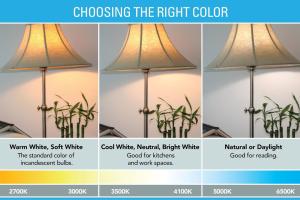How to Select the Ideal Light Bulb for Any Fixture: A Comprehensive Guide

-
Quick Links:
- Introduction
- Understanding Light Bulbs
- Types of Light Bulbs
- Wattage and Lumens Explained
- Color Temperature: What You Need to Know
- Fixture Compatibility
- Energy Efficiency and Cost Savings
- Step-by-Step Guide to Choosing a Light Bulb
- Case Studies and Real-World Examples
- FAQs
Introduction
Choosing the right light bulb for your lighting fixture can seem overwhelming, especially with the myriad of options available today. Light bulbs not only illuminate our spaces but also influence mood, productivity, and even energy consumption. In this guide, we’ll dive deep into the various aspects of light bulbs, helping you make informed decisions that suit your needs and enhance your living environment.
Understanding Light Bulbs
Light bulbs serve the essential function of illuminating our spaces. However, not all light bulbs are created equal. Understanding the basics of how light bulbs work will aid you in making the best choice.
How They Work
Light bulbs produce light either by heating a filament (incandescent), by passing electricity through gas (fluorescent), or using semiconductors (LED). Each type has unique characteristics, benefits, and drawbacks.
Types of Light Bulbs
- Incandescent: Traditional bulbs; warm light but less energy-efficient.
- Compact Fluorescent Lamps (CFL): More efficient than incandescent; come in various colors.
- Light Emitting Diodes (LED): Highly efficient; long lifespan; available in various color temperatures.
- Halogen: A subtype of incandescent; brighter and more efficient.
- Smart Bulbs: Can be controlled via apps; offer features like dimming and color changing.
Wattage and Lumens Explained
When selecting a light bulb, understanding wattage and lumens is crucial. Wattage measures energy consumption, while lumens measure brightness. The goal is to find a balance between the two.
Understanding Wattage
Wattage indicates how much energy a bulb uses. For example, a traditional 60-watt incandescent bulb can be replaced with a 10-watt LED bulb while achieving similar brightness levels.
Calculating Lumens
To ensure adequate lighting, consider the lumens required for the space:
- Living Room: 100-300 lumens per square meter
- Kitchen: 300-500 lumens per square meter
- Bathroom: 300-600 lumens per square meter
Color Temperature: What You Need to Know
Color temperature, measured in Kelvins (K), impacts the mood of a room. Here’s a breakdown:
- Warm White (2700K-3000K): Cozy ambiance, ideal for living rooms.
- Neutral White (3500K-4100K): Great for kitchens and bathrooms.
- Cool White (5000K-6500K): Bright, alerting light, perfect for workspaces.
Fixture Compatibility
Before purchasing a bulb, ensure it fits your fixture. Check the base type (e.g., E26, GU10) and wattage limitations specified by the manufacturer to avoid fire hazards.
Energy Efficiency and Cost Savings
Energy-efficient bulbs, particularly LEDs, save money on electricity bills and have longer lifespans. According to the U.S. Department of Energy, switching to LED bulbs can save a household over $225 in energy costs over the bulb's lifetime.
Step-by-Step Guide to Choosing a Light Bulb
- Identify the fixture and base type.
- Determine the desired brightness in lumens.
- Choose your preferred color temperature.
- Consider energy efficiency and lifespan.
- Purchase the bulb and install it safely.
Case Studies and Real-World Examples
Consider a case where a family switched from incandescent bulbs to LED bulbs throughout their home. They reported a 75% reduction in energy costs, along with enhanced lighting quality. Such transformations are becoming increasingly common as more consumers become aware of the benefits of energy-efficient lighting.
FAQs
- What type of light bulb is best for my needs?
Consider the function of the space, desired brightness, and energy efficiency. - Are LED bulbs worth the investment?
Yes, they save money in the long run due to lower energy costs. - Can I use LED bulbs in any fixture?
Check the compatibility of the fixture and bulb base. - How do I know what wattage I need?
Calculate based on the required lumens for the area. - What is the lifespan of an LED bulb?
Typically 15,000 to 50,000 hours, depending on the brand. - Do color temperatures affect mood?
Yes, warmer tones create a cozy atmosphere, while cooler tones encourage alertness. - Can I dim LED bulbs?
Yes, but ensure they are labeled as dimmable. - How do I dispose of old light bulbs?
Follow local regulations for disposal, especially for CFLs which contain mercury. - What is the difference between a smart bulb and a regular bulb?
Smart bulbs can be controlled via smartphone apps and may have additional features. - Are there any safety concerns with light bulbs?
Always follow manufacturer guidelines, especially regarding wattage limits.
Random Reads
- How to enable developer mode iphone ipad
- Create infinite water supply minecraft
- Create id cards online
- Check java version cmd
- Check imei iphone
- Build an iron farm in minecraft
- Bootable windows xp iso guide
- How to get dig pokemon emerald
- How to convert word to pdf
- How to secretly play video games when youre grounded